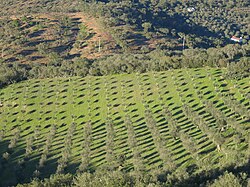Évora Monte
| Évora Monte | ||||||
|---|---|---|---|---|---|---|
|
||||||
| Basic data | ||||||
| Region : | Alentejo | |||||
| Sub-region : | Alentejo Central | |||||
| District : | Évora | |||||
| Concelho : | Estremoz | |||||
| Coordinates : | 38 ° 46 ′ N , 7 ° 43 ′ W | |||||
| Residents: | 569 (as of June 30, 2011) | |||||
| Surface: | 99.39 km² (as of January 1, 2010) | |||||
| Population density : | 5.7 inhabitants per km² | |||||
Évora Monte (also Evoramonte ) is a small fortified place and a municipality ( Freguesia ) in the Alentejo in Portugal . On a hill 470 m above sea level, 569 inhabitants live in the place (as of June 30, 2011) on an area of 99.4 km². The alternative place name of Évora Monte is Santa Mara. The municipality belongs to the district of Estremoz .
history
Évoramonte is a place already settled in Roman times, which was fortified into a castle by the Moors and continued to be used by King Dinis in 1306. The castle was so badly damaged by an earthquake in 1531 that it was rebuilt under King João III. Had to be renovated. On May 26, 1834, the Évoramonte Agreement was signed here, which put an end to the war of succession between Pedro I and his brother Miguel. In contrast to the liberal-minded Pedro, the absolutist Miguel lost in the Battle of Asseiceira , renounced the crown in the Évoramonte Agreement and went into exile.
Attractions
A steep, paved footpath leads from the small, picturesque village up to the castle . The Roman fort was further developed by the Moors into an Alcázar , which was converted into a Gothic fort, the Castelo , by the Portuguese after the Portuguese Reconquista . This massive symmetrical castle with four corner towers, reminiscent of a medieval keep , has three storeys. From above you have an excellent view over large parts of the Alentejo, weather permitting. Two stone ropes running around the facade and tied with a knot in the middle of the facade have a symbolic meaning: The lords of the castle came from the Portuguese royal house of Bragança, whose motto "Despois vós, nós" (after you, we) with the double Meaning of the Portuguese word nós plays: nós means both we and knot.
The church ( Igreja Matriz ) from the 15th century stands out due to the unconventional design of the bell tower. The Igreja da Misericórdia from the 16th century is completely clad inside with azulejos .
Individual evidence
- ↑ www.ine.pt - indicator resident population by place of residence and sex; Decennial in the database of the Instituto Nacional de Estatística
- ↑ Overview of code assignments from Freguesias on epp.eurostat.ec.europa.eu
Web links
- Map of the Freguesia Évora Monte at the Instituto Geográfico do Exército
- Aerial view of Evora Monte




